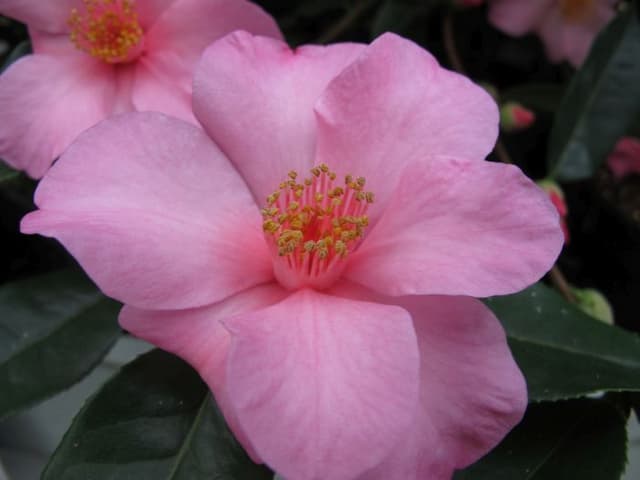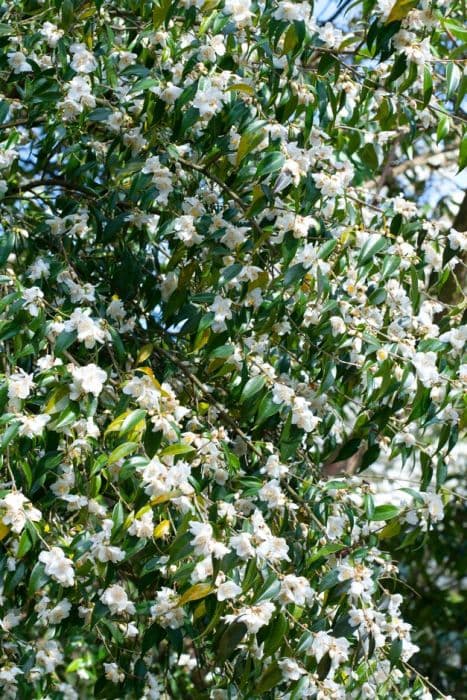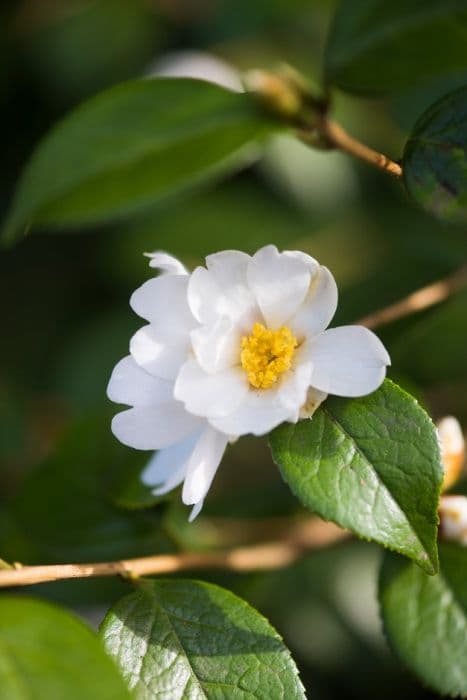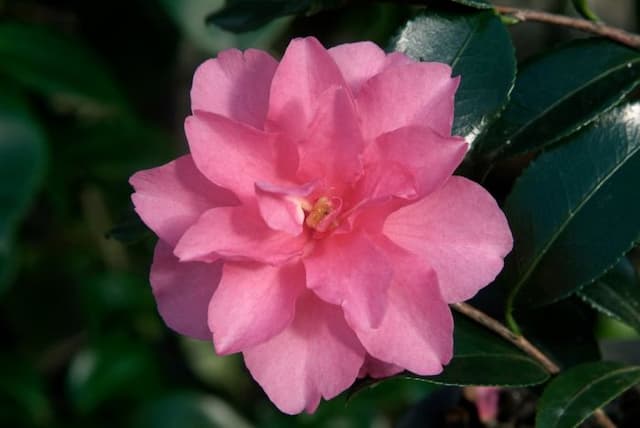Japanese Camellia Camellia japonica 'Pink Dawn'

ABOUT
The Camellia japonica 'Pink Dawn' is a visually striking plant well-known for its lush, glossy green leaves and large, showy pink flowers that bloom from late winter to spring. Each bloom of this camellia is a delightful, soft pink shade with petals arranged in a formal, peony-like form. The petals can range in texture from velvety to having a more satiny sheen, creating a visual allure as light plays across their surfaces. The edges of the petals may be softly ruffled, adding to the romantic appearance of the flower. The green foliage of Camellia 'Pink Dawn' presents a perfect, dark contrast against the delicate pink of its blooms, making the flowers stand out even more in a garden setting. The leaves themselves are leathery and thick, with a sturdy feel and a slightly serrated edge that gives them a sophisticated outline. In full bloom, this variety of camellia forms a dazzling floral display that attracts the attention of onlookers and provides a beautiful splash of color when many other plants are not in their prime flowering period.
About this plant
 Names
NamesFamily
Theaceae
Synonyms
Japanese Camellia, Rose Of Winter, Tsubaki
Common names
Camellia japonica 'Pink Dawn'.
 Toxicity
ToxicityTo humans
Japanese camellia, as a species, is generally recognized as non-toxic to humans. Therefore, 'Pink Dawn', a cultivar of Camellia japonica, is not considered poisonous. Ingesting parts of this plant is not expected to cause any significant symptoms of poisoning or adverse health consequences in humans. Despite this, any plant material can potentially cause mild stomach upset if ingested in large quantities, so it is still advisable to avoid eating it.
To pets
Japanese camellia, including the 'Pink Dawn' variety, is commonly not listed as toxic to pets such as dogs and cats. It is not expected to produce any severe symptoms of poisoning if pets ingest parts of this plant. As a precaution, keep in mind that individual pets might have sensitivities or allergic reactions to any plant material, which could result in mild gastrointestinal upset, so monitoring for any unusual behavior after ingestion is still wise.
 Characteristics
CharacteristicsLife cycle
Perennials
Foliage type
Evergreen
Color of leaves
Green
Flower color
Pink
Height
6-10 feet (1.8-3 meters)
Spread
6-10 feet (1.8-3 meters)
Plant type
Shrub
Hardiness zones
7
Native area
Japan
Benefits
 General Benefits
General Benefits- Aesthetic Appeal: Camellia japonica 'Pink Dawn', commonly known as Japanese camellia, produces beautiful pink flowers that enhance the visual appeal of gardens and landscapes.
- Year-Round Interest: This plant offers evergreen foliage, providing a constant backdrop of green throughout the seasons.
- Low Maintenance: Japanese camellia requires relatively little care once established, making it ideal for gardeners of all skill levels.
- Drought Tolerance: Once established, it has a moderate tolerance to drought, reducing the need for frequent watering under normal conditions.
- Versatility: It can be used in a variety of landscape designs, including as a specimen plant, in borders, and as a hedge or screen.
- Cold Resistance: Japanese camellia is relatively cold-hardy, making it suitable for growing in temperate climates.
- Wildlife Attraction: The flowers may attract pollinators like bees, thus contributing to the health of your garden ecosystem.
- Long Blooming Period: It has a long blooming period which typically extends from late winter through spring, offering color when many other plants are dormant.
 Medical Properties
Medical PropertiesThis plant is not used for medical purposes.
 Air-purifying Qualities
Air-purifying QualitiesThis plant is not specifically known for air purifying qualities.
 Other Uses
Other Uses- Camellia japonica 'Pink Dawn', known as Japanese camellia, can be used as a natural fabric dye, providing a range of pink hues depending on the mordant used.
- With its glossy, evergreen leaves, Japanese camellia can be crafted into decorative garlands and wreaths for festive seasons or special events.
- The petals of Japanese camellia can be used in crafting to make eco-friendly confetti for weddings or celebrations.
- Japanese camellia's wood, being hard and durable, can be utilized in creating small pieces of furniture or intricate wood carvings.
- The plant can be incorporated into landscape design to create privacy hedges or living fences due to its dense foliage.
- Japanese camellia can be used as a natural alternative to wrapping material by utilizing its large, sturdy leaves.
- The blooms of Japanese camellia can serve as a source of natural pigment for botanical inks and watercolor paints.
- Japanese camellia can be cultivated for bonsai, creating miniature landscapes and intricately shaped plants through careful pruning and maintenance.
- The flowers can be pressed and preserved in books or frames, making permanent artistic decorations or keepsakes.
- Japanese camellia's lush foliage and flowers can be used as a backdrop or setting for photography, adding natural elegance to the scene.
Interesting Facts
 Feng Shui
Feng ShuiThe Camellia is not used in Feng Shui practice.
 Zodiac Sign Compitability
Zodiac Sign CompitabilityThe Camellia is not used in astrology practice.
 Plant Symbolism
Plant Symbolism- Admiration: The camellia flower is often associated with deep admiration for someone's talents or qualities.
- Perfection: Its flawless and delicate form symbolizes the quest for perfection in many aspects of life.
- Love: In particular, the pink camellia represents a longing for someone and is often given to express romantic interest.
- Gratitude: Giving a camellia is a way to show gratitude or thank someone for a favor.
- Longevity: Since camellias are evergreen and can live for many years, they symbolize long life and faithfulness.
- Refinement: The camellia's elegant appearance signifies refinement and sophistication.
 Water
WaterThe common camellia, specifically 'Pink Dawn,' prefers consistent moisture and should be watered thoroughly to keep the soil evenly moist but not soggy. The frequency of watering depends on the weather conditions and soil drainage, but on average, it should be watered once a week with about 1 to 1.5 gallons per watering session. During hot, dry spells, you may need to increase the frequency to twice a week. Overhead irrigation should be avoided to protect the flowers. It's crucial to reduce watering in the winter months when the plant is not actively growing.
 Light
LightCamellias like 'Pink Dawn' thrive in partial shade, with protection from the intense afternoon sun. An ideal spot would be under the dappled shade of trees or on the north side of a building. Bright, indirect sunlight will help the camellia flourish without the risk of leaf burn or excessive drying of the soil.
 Temperature
TemperatureCamellias such as 'Pink Dawn' are hardy in a temperature range of 20 to 85 degrees Fahrenheit. However, they perform best in conditions where the climate is mild and the ideal growing temperature is between 60 and 70 degrees Fahrenheit. They can tolerate brief periods outside this range but sustained extremes can be harmful to the plant.
 Pruning
Pruning'Pink Dawn' camellias should be pruned to maintain shape and encourage vigorous growth. Pruning is best done after flowering, usually late spring or early summer. Remove dead or weak branches and thin out dense areas to allow light and air to penetrate the plant. Pruning every 2-3 years is typically sufficient for overall health and aesthetics.
 Cleaning
CleaningAs needed
 Soil
SoilPink Dawn Camellias require well-draining, acidic soil with a pH between 5.5 and 6.5. An ideal soil mix for Camellia japonica 'Pink Dawn' would consist of equal parts organic compost, pine bark, and perlite or vermiculite to aid in moisture retention and aeration.
 Repotting
RepottingPink Dawn Camellias should be repotted every 2-3 years or when rootbound. They prefer to be slightly root-bound, so don't choose a pot that is excessively larger than the previous one.
 Humidity & Misting
Humidity & MistingPink Dawn Camellias thrive best in moderate to high humidity levels, ideally around 40-60%. This mimics their natural humid forest habitat. Avoid placing them in very dry environments.
 Suitable locations
Suitable locationsIndoor
Place in bright, indirect light and maintain humidity.
Outdoor
Choose a sheltered spot with dappled sunlight and protect from frost.
Hardiness zone
7-9 USDA
 Life cycle
Life cycleCamellia japonica 'Pink Dawn', commonly known as the Japanese camellia, begins its life as a seed, which upon germination develops into a small seedling with a basic root system and cotyledons for nutrient absorption. As it matures, it grows into a shrub with glossy evergreen leaves and establishes a more extensive root system. The plant then enters a vegetative stage, focusing on leaf and branch growth to form a sturdy framework that supports its blooms. The reproductive phase follows, typically starting in late winter to early spring, where it produces large, ornate pink flowers that attract pollinators for fertilization. After pollination, it sets seed within a fruit capsule, completing its reproductive cycle. The plant enters a period of dormancy in the colder months, conserving energy before repeating its growth cycle in the following season.
 Propogation
PropogationPropogation time
Spring-Early Summer
Camellia japonica 'Pink Dawn', commonly known as the Japanese Camellia, is often propagated through semi-hardwood cuttings. This popular method is usually performed in late summer after the season's growth has begun to mature. Cuttings of about 4 to 6 inches (10 to 15 centimeters) long are taken from healthy branches. The lower leaves are removed, and the base of the cutting is treated with a rooting hormone to encourage root development. The prepared cuttings are then inserted into a potting medium that drains well, such as a mix of perlite and peat moss, and kept in a humid environment with indirect light. It can take several weeks to a few months for the cuttings to root. After rooting, the young plants are gradually acclimated to less humid conditions before being planted outdoors.









